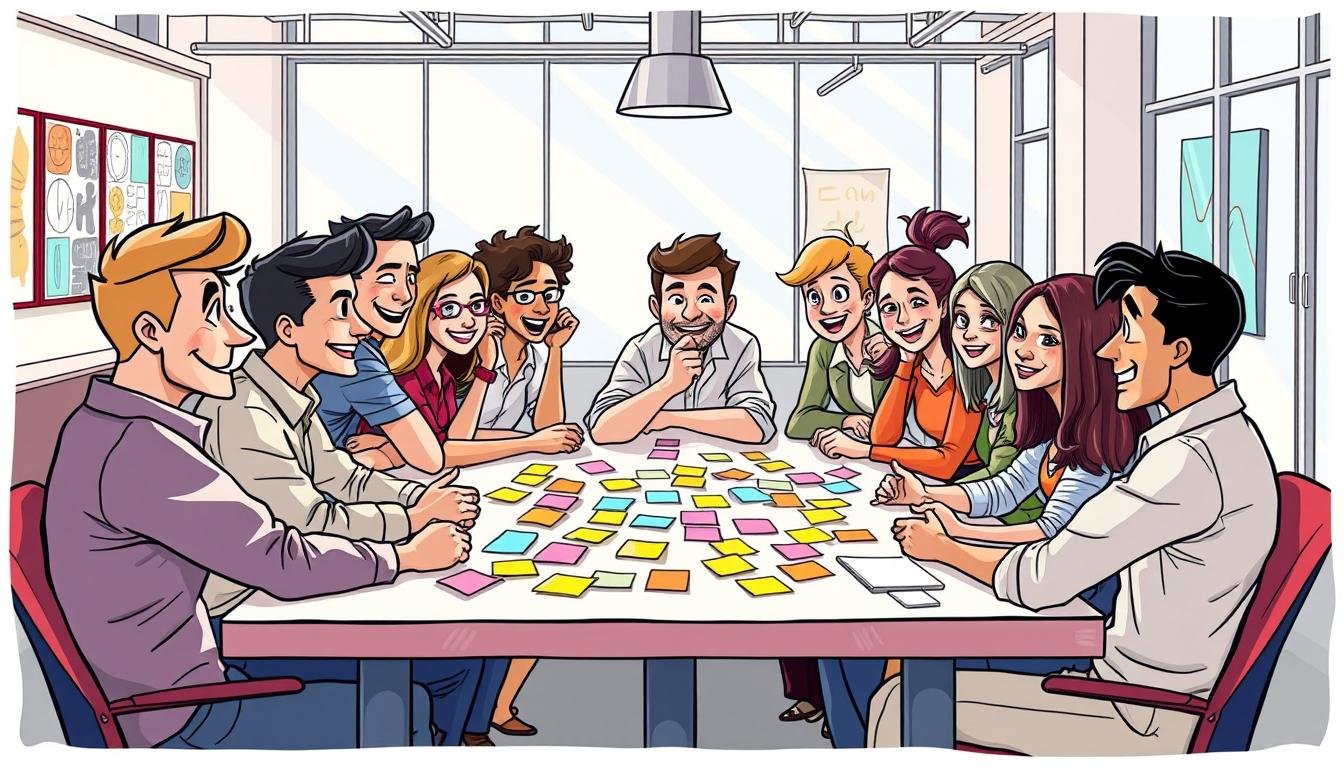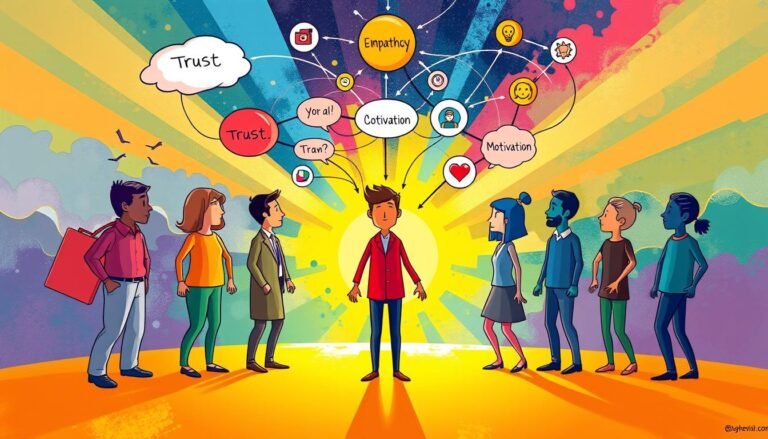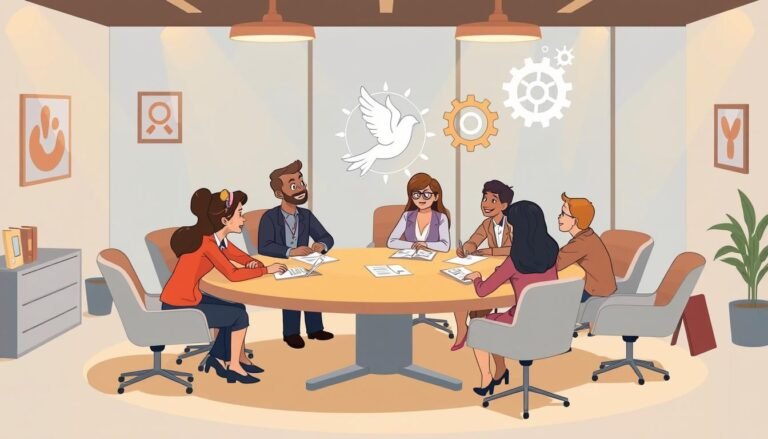Avoiding Groupthink: Psychological Tactics for Better Organizational Decisions
Ever wondered why smart people in a team can make bad choices? This is called groupthink. It can stop innovation and cause big mistakes. But, how can companies avoid this and encourage thinking for themselves?
Groupthink is a silent enemy of creativity and good decision-making. It happens when people want to agree more than think clearly. Irving Janis, who coined the term in 1972, said the best decisions come from healthy debate and different views. Yet, many companies find it hard to escape this trap.
To fight groupthink, companies must use tactics that promote independent thinking and feedback. This not only makes decisions better but also helps innovation grow. By understanding and fighting conformity bias, businesses can solve problems more creatively.
Key Takeaways
- Groupthink stifles creativity and can lead to poor organizational decisions
- Irving Janis introduced the concept in 1972, emphasizing the need for diverse perspectives
- Psychological safety is crucial for preventing groupthink, especially for new and lower-level employees
- Encouraging low-risk conflict can help surface the best ideas within a team
- Strategies like anonymous contributions and thorough problem understanding can combat groupthink
Understanding Groupthink: Definition and Origins
Groupthink was first mentioned by Yale University’s Irving Janis in 1972. It happens when group members value harmony over thinking critically. This idea is key to understanding why groups make bad decisions.
Irving Janis’s Groundbreaking Research
Janis found eight signs of groupthink, like ignoring differences and making excuses. He looked at big events like the Bay of Pigs and the Vietnam War. He saw how groupthink could lead to these problems.
The Psychology Behind Conformity in Groups
Groups often want to stick together and feel the same. Things like strong leaders and feeling cut off from others can make groupthink worse. This can silence different opinions and lead to bad choices.
Common Misconceptions About Groupthink
Some think groupthink only happens in bad teams. But it’s more common in tight groups with strong leaders. Another myth is that groupthink always causes disasters. While it can, it can also make decisions faster and boost confidence in some cases.
| Groupthink Symptom | Description | Impact |
|---|---|---|
| Illusion of Invulnerability | Excessive optimism | Underestimation of risks |
| Collective Rationalization | Dismissal of warnings | Ignoring critical information |
| Self-Censorship | Suppression of doubts | Limited alternative viewpoints |
Recognizing the Signs of Groupthink in Your Organization
Groupthink can quietly invade your workplace, causing bad decisions and less innovation. It’s vital to spot its signs to keep your work environment healthy and productive.
A big warning sign is when meetings lack dissent. If team members don’t share different views, it’s a problem. This often happens when everyone thinks they agree without really talking about it.
Another sign is censorship. Team members might not speak up because they fear being mocked or left out. This can be made worse by ‘mindguards’ who block out opposing views.
- Unquestioned beliefs in the group’s decisions
- Stereotyping of outsiders or opposing viewpoints
- Pressure to conform to the majority opinion
- Rationalization of warnings that challenge group’s assumptions
A study found that 85% of businesses see groupthink as a big risk to making good decisions, especially in planning. To fight this, 80% of companies work hard to bring in different viewpoints.
| Symptom | Percentage of Companies Observing |
|---|---|
| Conformity pressure | 90% |
| Illusion of invulnerability | 75% |
| Stereotyping | 70% |
By watching for these signs, you can start to build a workplace that values open talk and thinking critically.
The Impact of Groupthink on Decision-Making Processes
Groupthink has a big impact on how well organizations perform. It was first noticed by Irving Janis in 1972. It can cause bad decisions and stop new ideas from coming up. Let’s see how groupthink affects businesses and their ability to change with the market.
Case Studies of Groupthink Failures
In a fund management case, a group made a bad decision without thinking it through. This led to an 80% drop in shares. It shows how following the crowd can ignore important thinking in big decisions.
Long-Term Consequences for Businesses
Groupthink can really hurt businesses in the long run. It can cause:
- Less profit because of bad choices
- Missing the best solutions to problems
- Not learning from mistakes because of no feedback
Missed Opportunities and Innovation Stagnation
Groupthink’s worst effect is stopping innovation. When different ideas are not heard, creativity goes down. This means missing chances and not being able to change with the market. It holds back growth.
| Groupthink Symptom | Impact on Decision-Making |
|---|---|
| Illusion of invulnerability | Too much optimism, taking too many risks |
| Collective rationalization | Ignoring warnings, not seeing threats |
| Self-censorship | Not sharing important thoughts |
| Pressure on dissenters | Keeping different views quiet |
To fight groupthink and improve decision-making, companies need to encourage independent thinking. They should value different ideas and make sure everyone can speak up. This way, they can be more innovative and successful over time.
Fostering Psychological Safety to Combat Groupthink
Creating a safe space for open communication is key to fighting groupthink. Leaders set the tone, encouraging team members to speak up without fear. This approach uncovers diverse views, spots blind spots, and challenges old habits, leading to smarter choices and fresh ideas.
Research shows groupthink thrives in similar teams aiming to stay unified. To counter this, build psychological safety. This means team members feel secure sharing ideas, making mistakes, or offering bold suggestions without judgment.
Achieving psychological safety takes consistent effort and clear team talks. It’s especially important when stress is high and decisions are rushed. Managing stress and allowing ample time for brainstorming helps reduce groupthink risks.
Try these tactics to boost psychological safety:
- Encourage respectful debate
- Value different opinions
- Use brainwriting for independent thought
- Hold regular feedback sessions
Google’s “Project Aristotle” found psychological safety was the top factor in team success. Teams with high psychological safety outperform those without. They solve problems better, innovate more, and keep employees longer.
By fostering a culture of psychological safety and open communication, you’ll make better decisions and keep your team engaged and productive.
Strategies for Encouraging Diverse Perspectives
It’s important to have different views to avoid groupthink and make better choices. McKinsey & Co. found that companies with diversity and inclusion do 35% better than others. Let’s look at ways to bring more varied ideas into your team.
Implementing the Devil’s Advocate Role
Choose someone to play devil’s advocate in meetings. This person challenges ideas and finds flaws. It’s good to switch this role around to get new views and avoid bias.
Utilizing Subgroup Discussions
Split your team into smaller groups for talks before coming back together. This helps everyone share more and quieter people speak up. A study showed diverse teams make decisions 87% better.
Promoting Independent Research and Analysis
Ask team members to do their own research before meetings. This way, everyone has informed opinions and less likely to agree too much. Give time for each person to share their ideas and get feedback. This boosts creativity and thinking.
- Rotate meeting leads to encourage diverse leadership styles
- Actively encourage respectful dissent and debate
- Seek input from various stakeholders to drive inclusion
- Create a safe environment for expressing opinions
Using these strategies, you’ll build a culture that values different views and group talks. This not only stops groupthink but also leads to more creative and effective decisions.
The Role of Leadership in Preventing Groupthink
Leaders are key in stopping groupthink. Their influence can greatly affect a team’s decisions. By being impartial and encouraging open talk, leaders help bring out different views and critical thinking.
Good leaders make sure everyone feels safe to share their thoughts. This stops the feeling that everyone agrees, a big sign of groupthink. They should promote debate and value different opinions to avoid rushing into decisions.
Studies reveal that leaders with a strong desire for power can harm group decisions. To fight this, leaders should:
- Stay neutral in the beginning
- Encourage everyone to share their ideas
- Don’t share their own opinions too soon
- Accept and use constructive feedback
- Value diverse opinions
By using these methods, leaders can lower the chance of groupthink and make better decisions for the organization. Remember, a leader’s job is to guide, not control, the decision-making process.
| Leadership Approach | Impact on Groupthink |
|---|---|
| Directive | Increases risk |
| Impartial | Reduces risk |
| Open communication | Minimizes risk |
Groupthink: Identifying and Addressing the Eight Symptoms
Groupthink can cause bad decisions in teams. Knowing its signs helps teams steer clear. Let’s look at the main symptoms and how to tackle them.
Illusions of Invulnerability and Unanimity
Groups often feel they can’t fail. They think their choices are perfect. This false sense of safety makes them overlook risks.
They also believe everyone agrees with them. This makes them less likely to share different views.
Rationalization and Stereotyping
Groups tend to ignore warnings and negative feedback. They rationalize away any doubts. Stereotyping outsiders is also common.
This limits the group’s ability to see other perspectives. It narrows their view.
Self-Censorship and Direct Pressure to Conform
Members often hide their doubts. They practice self-censorship. There’s also pressure to agree with everyone.
| Symptom | Description | Prevention Strategy |
|---|---|---|
| Illusion of Invulnerability | Group feels invincible | Encourage critical thinking |
| Rationalization | Dismissing warning signs | Seek outside opinions |
| Self-Censorship | Hiding doubts or concerns | Create safe spaces for dissent |
| Pressure for Uniformity | Forcing agreement | Value diverse viewpoints |
Spotting these symptoms is key. Teams can then work on open communication and diverse thinking. This leads to better decisions and stronger teams.
Leveraging Diversity to Enhance Decision-Making
Embracing diversity is crucial for better decision-making. Teams with different views often do better than those with similar ones. This leads to better financial results and new ideas.
Research shows diverse teams in business do 33% better financially. This is especially true in finance. In tech, diverse teams make decisions twice as fast.
The advantages of diversity are seen across many fields:
- Retail: Teams with more women at the top do 21% better financially.
- Healthcare: Diverse leaders keep employees 50% longer.
- Manufacturing: Diverse teams solve problems 87% better.
- Hospitality: Inclusive teams see 20% more happy customers.
Diversity of thought adds new views. Background diversity brings different experiences. Experience diversity helps solve problems in many ways.
| Diversity Type | Impact on Decision-Making |
|---|---|
| Thought Diversity | Reduces groupthink, increases creativity |
| Background Diversity | Enhances cultural understanding, improves market insights |
| Experience Diversity | Brings varied skills, improves problem-solving |
Creating an inclusive space lets companies use their diverse talent fully. This leads to more creative solutions, better handling of complex issues, and higher performance overall.
Tools and Techniques for Objective Analysis in Group Settings
Good group decisions need clear analysis and many viewpoints. Let’s look at some great tools for fair talks and new ideas.
Structured Decision-Making Frameworks
Frameworks help solve problems in a set way. The RAPID model from Bain and Company, for example, makes sure everyone has a role. This way, everyone can contribute well.
The Nominal Group Technique (NGT) is another good tool. It uses votes with index cards to pick the best ideas. This helps everyone have a say, not just the loudest voices.
Anonymous Feedback Systems
Tools for anonymous feedback let people share honestly. ThoughtExchange, for instance, lets you ask open questions and vote. This makes group decisions better by removing fear of being judged.
| Technique | Key Feature | Benefit |
|---|---|---|
| Delphi Method | Anonymous questionnaires | Reaches group consensus |
| Stepladder Technique | Gradual inclusion of members | Prevents groupthink |
| Dialectical Inquiry | Opposing viewpoints analysis | Highlights pros and cons |
Pre-Meeting Preparation Strategies
Getting ready for meetings is key. Send out agendas early and ask people to think of ideas. This way, everyone comes ready to contribute.
Using these tools and methods helps groups make better decisions. It leads to more creative and complete solutions.
Conclusion: Building a Culture of Critical Thinking and Open Communication
Creating a workplace that values critical thinking and open communication is key to avoiding groupthink. Studies show that about 65% of organizations face groupthink issues during important meetings. This highlights the need for change in how teams make decisions.
By fostering diverse perspectives, companies can boost innovation by 40%. Encouraging employees to speak up and share their ideas is crucial. Sadly, 75% of workers admit to holding back their thoughts in group settings. To fix this, leaders must create a safe space for all voices to be heard.
Using tactics like assigning a devil’s advocate can cut down groupthink by 30%. Teams that do their own research before meetings make 25% better choices. These simple steps can lead to big improvements. In fact, workplaces that welcome independent thinking see a 60% jump in successful projects.
Building a culture of continuous learning takes time and effort. But the payoff is worth it. Companies that make this shift see higher employee engagement and better results. By using the strategies in this article, organizations can create an environment where great ideas thrive and smart decisions become the norm.
Source Links
- 5 Strategies to Avoid Groupthink – ACHIEVE Centre for Leadership
- How to avoid groupthink – tips and tricks
- How to avoid groupthink in teams: 5 tips for better teamwork | Mural
- What Is Groupthink? Definition, Characteristics, and Causes
- Groupthink: Origins of a Word
- Groupthink | Psychology, Decision-Making & Consequences
- Identifying and Combating Groupthink in Your Team
- Groupthink: How to Recognize and Eliminate | Mailchimp
- The Psychology Behind Why We Strive for Consensus
- Groupthink
- The Impact of Groupthink on Business Decision-Making
- Diverse Perspectives on the Groupthink Theory – A Literary Review
- Groupthink: Definition, Examples, and Tips – Work Life by Atlassian
- No title found
- How Leaders Can Foster Psychological Safety on Teams
- 8 Ways to Encourage Diverse Perspectives at Work | Confetti 🎉
- How can you encourage diverse perspectives to prevent groupthink?
- PRDV213: Leadership’s Role in Groupthink | Saylor Academy
- What Is Groupthink and How Can Leaders Avoid It?
- Council Post: 3 Ways Groupthink Restricts Your Leadership
- 8 Symptoms of Groupthink – A Wealth of Common Sense
- 8 Symptoms of Groupthink You Need To Know
- Groupthink – The Decision Lab
- Diversity: How to Leverage Diversity for Better Decision Making – FasterCapital
- Strength in Differences: Leveraging Diversity to Enhance Team Performance
- Decision-Making Process – Ensuring Diverse Perspectives
- 10 of the Most Effective Group Decision Making Techniques | Fellow.app
- 5 Effective Group Decision-Making Techniques | ThoughtExchange
- Group Decision Making Process: Tools & Techniques for Perfect Team Collaboration
- Navigating ‘groupthink’ in the modern workplace: a threat to creativity and decision-making
- Critical thinking: Fostering Critical Thinking to Combat Groupthink – FasterCapital







